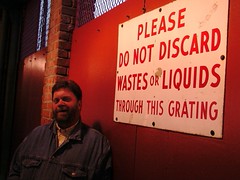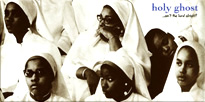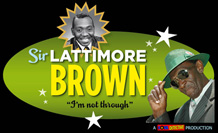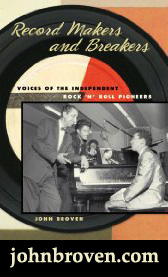Lattimore Brown - I'm Not Through Lovin' You (SS 7 2553)
 I'm Not Through Lovin' You
I'm Not Through Lovin' YouPART FOUR
After the bottom dropped out in Dallas, Lattimore drifted from New York back to Little Rock, but nothing much was happening. After a while, he got a call from his old pal, The Buzzard. "You ought to get on down here to Nashville," he told him, "we got it goin' on!" By the early sixties, Jefferson Street in North Nashville had developed into one of the premier showcases in the nation for real R&B. Spreading down the hill from both Tennessee State and Fisk Universities, the club scene was thriving, with young blacks from all over the South in town, and ready to shake it down.
After a while, he got a call from his old pal, The Buzzard. "You ought to get on down here to Nashville," he told him, "we got it goin' on!" By the early sixties, Jefferson Street in North Nashville had developed into one of the premier showcases in the nation for real R&B. Spreading down the hill from both Tennessee State and Fisk Universities, the club scene was thriving, with young blacks from all over the South in town, and ready to shake it down. When Leonard Chess decided to record a live album on Etta James in 1963, he chose the New Era Club on Jefferson Street as the location. The great Etta James Rocks The House offers a glimpse into what it was like on 'the strip' back then. Nashville, to be sure, is not the first place you think of when it comes to R&B but, in those days, it was considered the top spot on the Chitlin' Circuit, the place where performers pulled out all the stops. Lattimore was all over it.
When Leonard Chess decided to record a live album on Etta James in 1963, he chose the New Era Club on Jefferson Street as the location. The great Etta James Rocks The House offers a glimpse into what it was like on 'the strip' back then. Nashville, to be sure, is not the first place you think of when it comes to R&B but, in those days, it was considered the top spot on the Chitlin' Circuit, the place where performers pulled out all the stops. Lattimore was all over it. Jimmy Stewart had become kind of like the elder statesman of that world, and his apartment just off the main drag was like 'musician central'. Everybody from young kids coming up, to seasoned veterans like Lattimore hung out there in between gigs; "Jimmy had a piano in there, and we'd get together and write songs. At any given time there'd be six to eight of us up there, making us pallets on the floor. It was a two bedroom apartment. I'd be in there cooking neck bones and pinto beans, corn bread. If a musician only had one piece of bread he'd break it in half for his friend. That's the way we were, man... It was a bonding, like family. It's Love, that's what it is. We had Billy Cox up there, Larry Lee, and this kid that didn't have no name, he was just another guitar player... Jimi motherf#@kin' Hendrix, man!"
Jimmy Stewart had become kind of like the elder statesman of that world, and his apartment just off the main drag was like 'musician central'. Everybody from young kids coming up, to seasoned veterans like Lattimore hung out there in between gigs; "Jimmy had a piano in there, and we'd get together and write songs. At any given time there'd be six to eight of us up there, making us pallets on the floor. It was a two bedroom apartment. I'd be in there cooking neck bones and pinto beans, corn bread. If a musician only had one piece of bread he'd break it in half for his friend. That's the way we were, man... It was a bonding, like family. It's Love, that's what it is. We had Billy Cox up there, Larry Lee, and this kid that didn't have no name, he was just another guitar player... Jimi motherf#@kin' Hendrix, man!" Hendrix and Billy Cox were heading up the King Kasuals at that point, and were the house band at another fabled Jefferson Street club, the Del Morocco. In the liner notes to The Band Of Gypsys Return, Cox had this to say; "Look on the back of any number of old blues albums and you will see the name Jimmy Stewart, aka ‘Buzzard’. He was a trumpet player and arranger extraordinaire. Buzzard was also my mentor and was always there to help show Jimi and me the way..." He and Lattimore were 'the best of friends'. That must have been some apartment, huh?
Hendrix and Billy Cox were heading up the King Kasuals at that point, and were the house band at another fabled Jefferson Street club, the Del Morocco. In the liner notes to The Band Of Gypsys Return, Cox had this to say; "Look on the back of any number of old blues albums and you will see the name Jimmy Stewart, aka ‘Buzzard’. He was a trumpet player and arranger extraordinaire. Buzzard was also my mentor and was always there to help show Jimi and me the way..." He and Lattimore were 'the best of friends'. That must have been some apartment, huh? It was Buzzard who introduced Brown to John R, arguably one of the most influential people in R&B at that point. His nightly show on WLAC had listeners in every state east of the Rockies, and his feel for a good record kept them tuning back in. In 1964, he had formed a company called J.R. Enterprises to serve as an outlet to record some of the great music that was being made up there across the river on Jefferson Street. One of the first things he did was to hire a young songwriter and arranger named Allen Orange. Orange had worked with Allen Toussaint in New Orleans, and had come to Nashville after the bottom seemed to drop out of the Crescent City R&B scene the year before. Their first production together was on a local singer named Roscoe Shelton, who had previously been recording Blues for Excello, without selling too many records. Released on the tiny Sims label in 1965, Shelton took Orange composition Strain On My Heart to #25 R&B in early 1965.
It was Buzzard who introduced Brown to John R, arguably one of the most influential people in R&B at that point. His nightly show on WLAC had listeners in every state east of the Rockies, and his feel for a good record kept them tuning back in. In 1964, he had formed a company called J.R. Enterprises to serve as an outlet to record some of the great music that was being made up there across the river on Jefferson Street. One of the first things he did was to hire a young songwriter and arranger named Allen Orange. Orange had worked with Allen Toussaint in New Orleans, and had come to Nashville after the bottom seemed to drop out of the Crescent City R&B scene the year before. Their first production together was on a local singer named Roscoe Shelton, who had previously been recording Blues for Excello, without selling too many records. Released on the tiny Sims label in 1965, Shelton took Orange composition Strain On My Heart to #25 R&B in early 1965. This caught the attention of Monument Records chief Fred Foster, who had started up a subsidiary label for R&B called Sound Stage 7 in 1963. Foster, in a stroke of brilliance, approached John R about taking over the reins at the label, thereby assuring not only a steady stream of good records, but automatic airplay on the most listened to R&B show in the nation. Not bad. Shelton became the first artist he signed in early 1965, and John put the word out on the street that J.R. Enterprises was looking for talent. With Lattimore's years of experience and name recognition out there on the circuit, he wasted no time signing him up.
This caught the attention of Monument Records chief Fred Foster, who had started up a subsidiary label for R&B called Sound Stage 7 in 1963. Foster, in a stroke of brilliance, approached John R about taking over the reins at the label, thereby assuring not only a steady stream of good records, but automatic airplay on the most listened to R&B show in the nation. Not bad. Shelton became the first artist he signed in early 1965, and John put the word out on the street that J.R. Enterprises was looking for talent. With Lattimore's years of experience and name recognition out there on the circuit, he wasted no time signing him up. While we were on our way up to Memphis from Clarksdale on the road trip, Lattimore told us "Yup, I made my first record for John R at the Stax Studio with Willie Mitchell." We were like, "WHAT??" I figured this was Alzheimer's setting in, or just the scrambled ramblings of this old man... but he was right on the money! I had made a CD of the 45s I had on Lattimore for the car ride, and he picked out two songs in particular, our current selection and Don't Trust No One (now up on The A Side) and told us to listen closely:
While we were on our way up to Memphis from Clarksdale on the road trip, Lattimore told us "Yup, I made my first record for John R at the Stax Studio with Willie Mitchell." We were like, "WHAT??" I figured this was Alzheimer's setting in, or just the scrambled ramblings of this old man... but he was right on the money! I had made a CD of the 45s I had on Lattimore for the car ride, and he picked out two songs in particular, our current selection and Don't Trust No One (now up on The A Side) and told us to listen closely: "That's Steve Cropper right there, ain't it? And ain't nobody played the drums like Al Jackson! That Duck Dunn, he was the best bass player I ever worked with..." We were blown away. Really. This incredible record we have here is a hidden slice of the MGs in their prime... with one exception. I'm betting that's Isaac Hayes on the piano, as Booker was away at college in those days. Truly amazing, folks, and Lattimore is at his best. No doubt inspired by the fact that he's at Stax, recording with Otis Redding's band, he's really singing on this one. I love that whole soulful break-out there at the end... very, very cool. I asked him about what he said about Willie Mitchell being there... "Shit, ain't nobody did a session in Memphis without Willie... John R never did, anyway."
"That's Steve Cropper right there, ain't it? And ain't nobody played the drums like Al Jackson! That Duck Dunn, he was the best bass player I ever worked with..." We were blown away. Really. This incredible record we have here is a hidden slice of the MGs in their prime... with one exception. I'm betting that's Isaac Hayes on the piano, as Booker was away at college in those days. Truly amazing, folks, and Lattimore is at his best. No doubt inspired by the fact that he's at Stax, recording with Otis Redding's band, he's really singing on this one. I love that whole soulful break-out there at the end... very, very cool. I asked him about what he said about Willie Mitchell being there... "Shit, ain't nobody did a session in Memphis without Willie... John R never did, anyway." You know, it's common knowledge that Atlantic recorded both Wilson Pickett and Don Covay at Stax in 1965 (resulting in such classics as In The Midnight Hour and Sookie Sookie), but I never knew about this. Apparently, neither did Rob Bowman, as there's no mention of the sessions in Soulsville USA. Just over the moon about our discovery, the first stop we made when we got into town was the Stax Museum. The Media Director of the Soulsville Foundation, Tim Sampson, was as thrilled as we were with the news, and was kind enough to allow us to film Lattimore as he walked through the museum, talking about his experiences recording there. Unreal.
You know, it's common knowledge that Atlantic recorded both Wilson Pickett and Don Covay at Stax in 1965 (resulting in such classics as In The Midnight Hour and Sookie Sookie), but I never knew about this. Apparently, neither did Rob Bowman, as there's no mention of the sessions in Soulsville USA. Just over the moon about our discovery, the first stop we made when we got into town was the Stax Museum. The Media Director of the Soulsville Foundation, Tim Sampson, was as thrilled as we were with the news, and was kind enough to allow us to film Lattimore as he walked through the museum, talking about his experiences recording there. Unreal. I've since found out that John R recorded Sam Baker there as well (we'll talk more about that later on), and when you think about it, it makes sense. He was the one who 'stayed on' These Arms Of Mine after every other station in the country had stopped playing it. There are those who say that it was John R who 'made' Otis Redding, and consequently Stax, by believing in that record. I'm sure Jim Stewart (no relation to Buzzard...) was only too happy to let him use the studio (with visions of future airplay of Stax product dancing in his head), and Richbourg had found a way to get 'that sound' for his label, something he had been unable to do in Nashville up to that point... but it didn't last long. In December of 1965, Stewart barred all 'outside' artists from recording at his studio, ostensibly because he didn't like Jerry Wexler stealing his thunder. John R, and Lattimore, were going to have to figure something else out...
I've since found out that John R recorded Sam Baker there as well (we'll talk more about that later on), and when you think about it, it makes sense. He was the one who 'stayed on' These Arms Of Mine after every other station in the country had stopped playing it. There are those who say that it was John R who 'made' Otis Redding, and consequently Stax, by believing in that record. I'm sure Jim Stewart (no relation to Buzzard...) was only too happy to let him use the studio (with visions of future airplay of Stax product dancing in his head), and Richbourg had found a way to get 'that sound' for his label, something he had been unable to do in Nashville up to that point... but it didn't last long. In December of 1965, Stewart barred all 'outside' artists from recording at his studio, ostensibly because he didn't like Jerry Wexler stealing his thunder. John R, and Lattimore, were going to have to figure something else out...continued in PART FIVE


















10 Comments:
William Bell mentioned to me he used the King Kasuals as session men for his Peachtree records. He claimed the King Kasuals were his backing band. Had I known that Billy Cox and Hendrix were once Kasuals I had asked him if he toured with Hendrix in the band! Though Hendrix must have moved on by the time Peachtree was formed.
Kudos for another great chapter. Roscoe Shelton also recorded for John R at Stax (listen to "I Know Your Heart Has Been Broken" - Steve, Duck and Al are all over it).
Very cool, Jason! I wondered about that, as Roscoe, Sam, and Lattimore were the big three at the label at that point... I listened to the cut you mentioned (which is available on The Sound Stage 7 Story) and, as you said, it's the MGs for sure!
Who knew?
I still find it shocking that Elvis recorded in the Stax studios, using his own band! Can you imagine how that record, In Memphis I think it was, would have sound like if he had used the MGs!
This whole project should turn into a CD with liner notes methinks. I realize it would be a licensing nightmare, but why don't you propose it to the folks over at Kent or SoulJazz?
Wow ... I just got the Sound Stage 7 set a couple weeks and there were certain cuts (like Sam Baker's "Sometimes You Have to Cry") where I was thinking, "Man the guys in the band have the Stax sound down *perfect.*") Now I know why!
There's no picture on the last.fm page for Lattimore Brown. Mind if I grab one of yours? Maybe the one in front of the Stax sign?
Great series of posts, btw.
Oh, I forgot the last.fm link:
Lattimore Brown
Sure Harry, go for it... but, this kind of opens up a can of worms that I didn't want to get into as yet.
I mean, most of Lattimore Brown's Sound Stage 7 stuff is available on iTunes, etc. for a price. No matter who it is that is licensing this material to them, it seems to me that the artist has to retain SOME right to his own name. In other words, if you're selling a product that has a person's name attached, that person should be due some piece of the proceeds... I'm not talking about a 45 that gets sold on eBay, but a new digital product that's offered for sale.
I'm really not familiar with last.fm, but if somebody's making money off the sweat and toil of a man like Lattimore, there's got to be some kind of moral (if not legal) obligation to share the wealth.
thanks.
FWIW, at the moment I don't think there are any Lattimore Brown tracks streamable via last.fm. The page is just recording how many people have listened to his work on their computers. I'm not in any way attached to last.fm, btw; anyone can upload artist pictures.
Good job and keep it up.
Post a Comment
<< Home